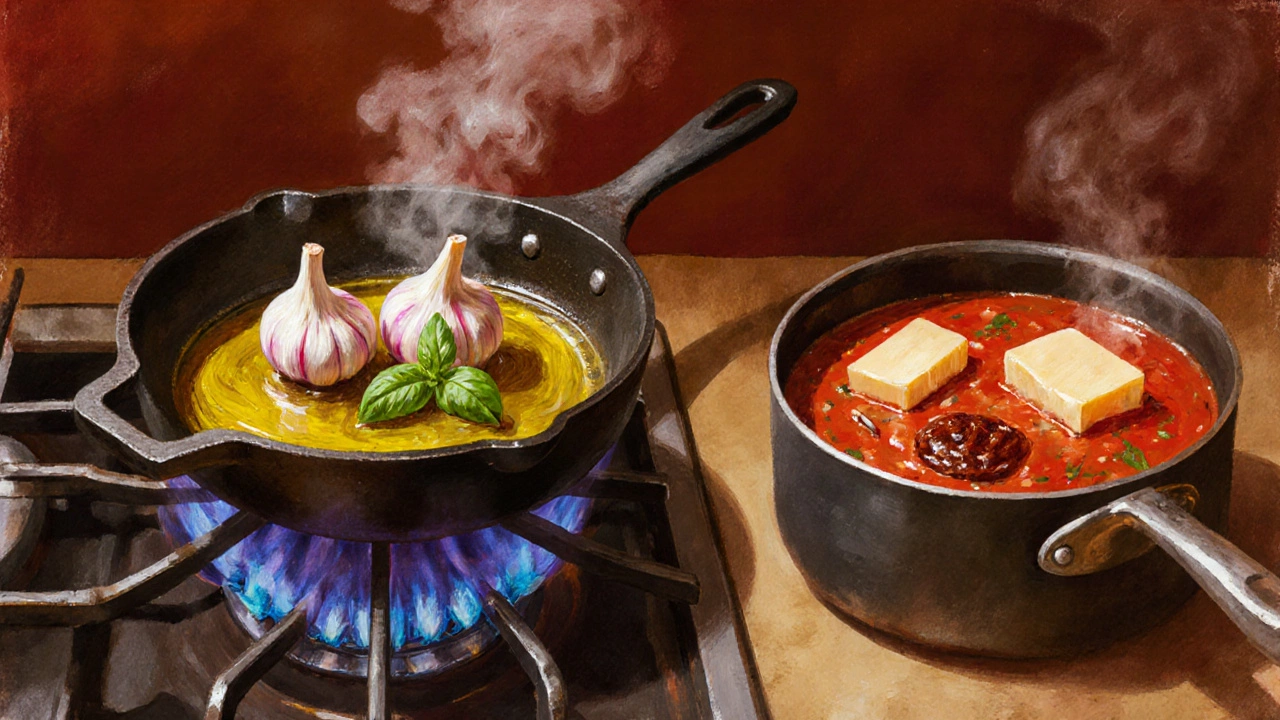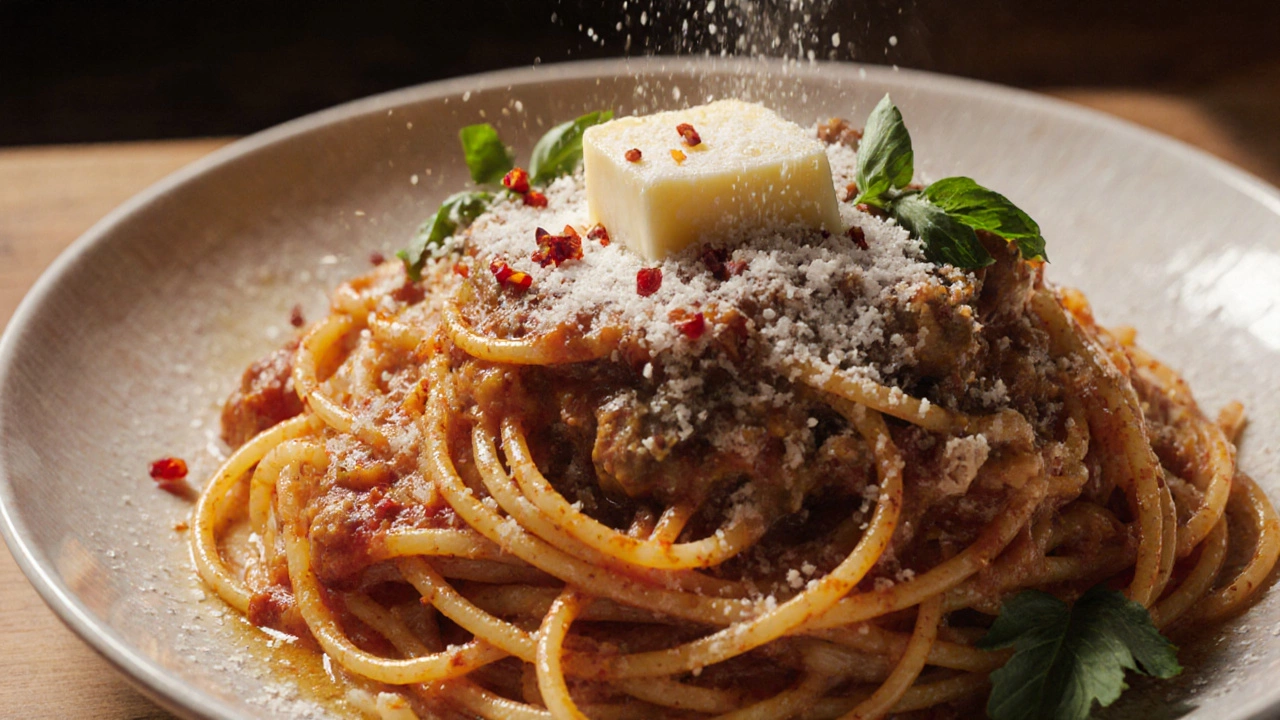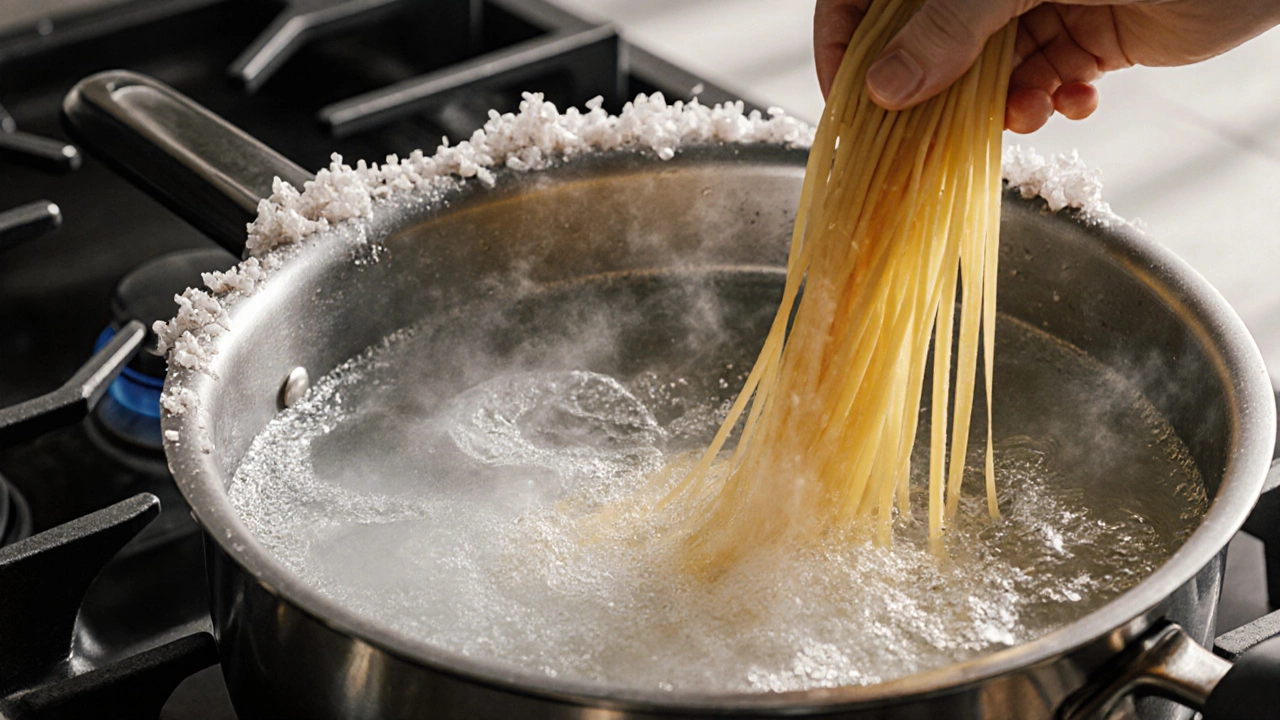Spaghetti Flavor Booster Calculator
Choose Your Sauce Type
Select Flavor Boosters
Flavor Profile Results
Ever wonder why some spaghetti dishes taste flat while others explode with depth? The secret isn’t a fancy sauce; it’s the little flavor‑building steps you add before, during, and after cooking the pasta. Below you’ll find seven practical ways to turn ordinary spaghetti into a mouth‑watering experience.
Key Takeaways
- Season the cooking water heavily - it’s the first flavor hit for the noodle.
- Reserve pasta water; it’s a natural thickener and flavor carrier.
- Infuse olive oil with aromatics like garlic and herbs before tossing.
- Use ripe tomatoes, a splash of broth, or a dash of umami‑rich ingredients to deepen sauce taste.
- Finish with cheese, butter, or a drizzle of quality oil for richness.
1. Salt the Water Like the Sea
When you boil Spaghetti is a long, cylindrical pasta that absorbs water quickly, gaining most of its flavor in the pot. A well‑salted pot mimics seawater, allowing the noodle itself to be seasoned from the inside out. aim for about 1‑2 tablespoons of kosher salt per 4‑5L of water. Too little salt leaves the pasta bland; too much makes it overly salty. The rule of thumb is: the water should taste like a lightly brined broth.
2. Keep Some Pasta Water for the Sauce
Before you drain the spaghetti, scoop out a cup of the hot cooking water. That liquid is packed with starch and dissolved salts, making it an excellent natural thickener. When you stir the reserved water into your sauce, it emulsifies the fats and helps the sauce cling to every strand. This step alone can elevate a simple tomato‑olive‑oil mix into a silky, restaurant‑quality coating.
3. Infuse Olive Oil with Garlic and Herbs
Olive oil is a fruit‑derived fat that carries flavor molecules. Gently warm a couple of tablespoons in a skillet, then add smashed Garlic cloves, crushed until fragrant, and a handful of fresh herbs such as Basil leaves, or dried oregano. Let the aromatics steep for 1‑2 minutes-don’t let the garlic brown, or it turns bitter. Toss the cooked spaghetti in this infused oil; the garlic‑herb perfume penetrates the noodle’s porous surface, adding a subtle, lingering note.
4. Build a Tomato Base with Umami Boosters
Ripe Tomatoes are the backbone of classic spaghetti sauce. Peel and crush them, then sauté with onion, carrot, and celery. To crank up the umami, stir in a splash of Parmesan cheese rind, a teaspoon of anchovy paste, or a dash of soy sauce. These ingredients release glutamates that deepen the sauce without making it salty. Let the sauce simmer for at least 20‑30 minutes so the flavors meld, then finish with a handful of grated Parmesan for brightness.

5. Add Dairy for Creamy Richness
A knob of Butter or a splash of heavy cream can turn a thin sauce into a velvety glaze. Butter also contributes diacetyl, which gives a buttery, slightly nutty taste that pairs beautifully with garlic‑infused oil. If you prefer a lighter touch, stir in a dollop of ricotta or a swirl of mascarpone right before serving; the creamy texture coats each strand and balances acidity.
6. Sprinkle Fresh Herbs and Spices at the End
Finishing herbs preserve their bright aromatics. Toss the plated spaghetti with chopped Parsley, a pinch of red‑pepper flakes, or a drizzle of chili‑infused oil for heat. For an earthy twist, sprinkle toasted pine nuts or a dusting of smoked paprika. These final touches add layers of flavor and visual appeal.
7. Finish with a Splash of Quality Liquid
Beyond pasta water, a splash of low‑sodium Chicken broth or vegetable stock can introduce savory depth. Add 1‑2 tablespoons just before the last stir; the broth’s natural glutamates reinforce the sauce’s umami profile while keeping the dish moist.
Flavor Boosters Comparison
| Booster | Flavor Impact | Ease of Use | Best Paired With |
|---|---|---|---|
| Heavily salted water | Baseline seasoning | Very easy | All sauces |
| Pasta water | Silky texture, binds sauce | Easy | Tomato‑based, oil‑based |
| Garlic‑infused olive oil | Rich aromatic depth | Easy | Simple aglio‑olio, seafood |
| Umami additives (Parmesan rind, anchovy paste) | Deep savory notes | Moderate | Tomato sauces |
| Butter or cream | Creamy richness | Easy | Light oil sauces |
| Fresh herbs & spices | Bright, fresh finish | Easy | Any dish at plating |
| Broth splash | Additional umami | Easy | Hearty, rustic sauces |

Putting It All Together: A Sample Workflow
- Boil a large pot of water; add 1½ tablespoons of kosher salt.
- Drop the spaghetti in; cook al dente (usually 9‑11 minutes).
- When the pasta has 2 minutes left, scoop out a cup of pasta water.
- Meanwhile, heat 2 tbsp Olive oil with 2 minced Garlic cloves and a pinch of dried oregano.
- In a separate pan, simmer crushed Tomatoes with a splash of Chicken broth, a grate of Parmesan cheese rind, and a dash of soy sauce.
- Drain the spaghetti, return to the pot, and toss with the garlic‑oil.
- Add the tomato‑broth mixture, pour in half of the reserved pasta water, and stir until glossy.
- Finish with a knob of Butter, a handful of fresh Parsley, and extra grated Parmesan.
Following this sequence ensures every flavor layer builds on the previous one, delivering maximum spaghetti flavor without any single ingredient overwhelming the dish.
Common Pitfalls and How to Avoid Them
- Under‑salting the water: The pasta itself will stay bland, forcing you to over‑season the sauce.
- Burning garlic: Burnt garlic adds bitterness; keep the heat low and watch closely.
- Using too much broth: It can dilute the sauce; limit to a few tablespoons and adjust with pasta water.
- Skipping the finish: A final dash of butter or cheese locks in flavor and gives a glossy finish.
Frequently Asked Questions
Can I add flavor boosters to gluten‑free spaghetti?
Yes. The same techniques work for rice‑ or corn‑based noodles. Just be mindful of the cooking time and use a gluten‑free broth if you’re avoiding wheat.
Is it okay to add oil directly to the boiling water?
Adding oil to the water prevents sticking, but it also coats the pasta, making sauce adhesion harder. It’s better to toss the cooked spaghetti with a bit of oil after draining.
How much salt should I use for a 2‑liter pot?
Aim for about 1½ teaspoons of kosher salt per 2L of water. Adjust to taste, but remember the noodles will absorb some of it.
What’s the best cheese for finishing spaghetti?
Aged Parmesan or Pecorino Romano adds sharp, salty umami. For a milder melt, try Grana Padano or a sprinkle of grated mozzarella.
Can I make a flavor‑boosted spaghetti without a sauce?
Absolutely. Toss hot spaghetti with garlic‑infused olive oil, a splash of pasta water, grated cheese, fresh herbs, and a knob of butter. The noodles become the star.
Next Steps
Pick one of the boosters you haven’t tried yet, and incorporate it into your next spaghetti dinner. Keep a quick note of how the flavor changes-over time you’ll develop a personal flavor formula that turns any jarred sauce into a signature dish.
Enjoy the process, and watch your spaghetti go from bland to unforgettable with just a few thoughtful tweaks.

